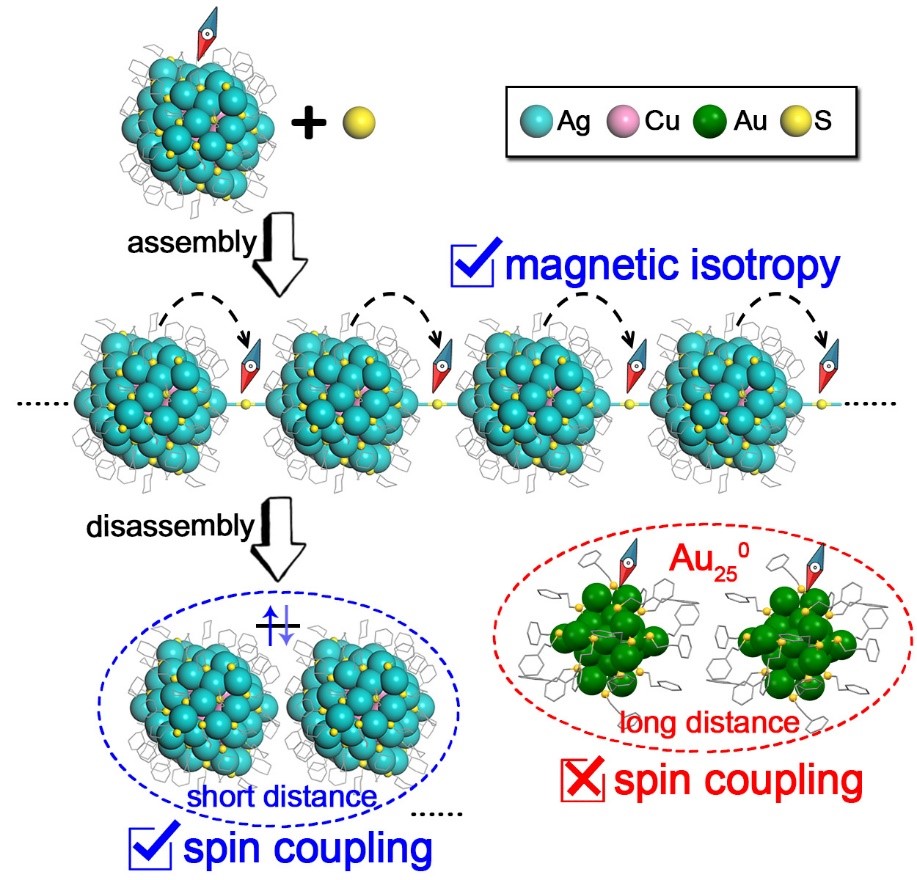
In a recent paper published in Nature Communications, a team led by Prof. WU Zhikun from the Institute of Solid State Physics, Hefei Institutes of Physical Science (HFIPS) of the Chinese Academy of Sciences (CAS), collaborated with Prof. ZENG Zhi group from the same institute and Prof. ZHAO Jijun group from Dalian University of Technology, discovered the spin transfer and spin coupling through the linear assembly of Ag-Cu alloy nanoclusters with sulfur.
The assembly of metal nanoparticles not only enriches their properties, but also helps to understand the structure-property relationships and the interactions between nanoparticles. However, due to the multi-distribution of metal nanocrystals, it is difficult to obtain atomically precise assembly structures; The recently emerging nanoclusters (ultrasmall nanoparticles)provide ideal building blocks for precise assembly due to their well-defined compositions and structures, however, few studies on atomically precise metal nanocluster (larger than 1 nm) assembly have been reported owing to the difficulty of synthesis and characterization.
In this study, the team prepared a linear assembly structure formed by linking two Ag77Cu22 clusters with one sulfur ion using a simultaneous synthesis and assembly strategy. The sulfur ions can be produced by the cleavage of carbon-sulfur and sulfur-hydrogen bonds of the thiols during the synthesis of the clusters, leading to the immediate link with clusters to form the assemblies.
Further studies showed that the magnetic moment in this linear assembled structure was transferred from the cluster to the sulfur, forming paramagnetic sulfur radicals, which exhibited magnetic isotropy due to the small spin-orbit coupling constants of sulfur and the absence of magnetic moment interaction between distant sulfur radicals. When the linear structures were disassembled in solution, the magnetic moment transferred back to the clusters, and subsequently spin coupling occurred. Notably, such spin coupling had not been reported in the magnetic Au250 clusters, which was interpreted by the interparticle distance dependent spin coupling. When the ligands were flexible and their lengths were short, the clusters could approach each other and the spin coupling occured within a certain distance. Otherwise it was difficult for the clusters to come close for coupling.
This work successfully achieved the linear assembly of the metal nanoclusters larger than 1 nm by using the adequate assembly strategy. It discovered and explained the spin transfer and distance-dependent spin coupling, which would have important implications for the future study of nanocluster magnetism and development of novel functional materials.
The above work was supported by the National Natural Science Foundation of China, the Natural Science Foundation of Anhui Province, and the President's Foundation of Hefei Institutes of Physical Science.

The magnetism performances of Ag77Cu22 nanoclusters after assembly and disassembly (The inset in red circle presents the absence of spin coupling in Au250 due to the long interparticle distance) (Image by XIA Nan).